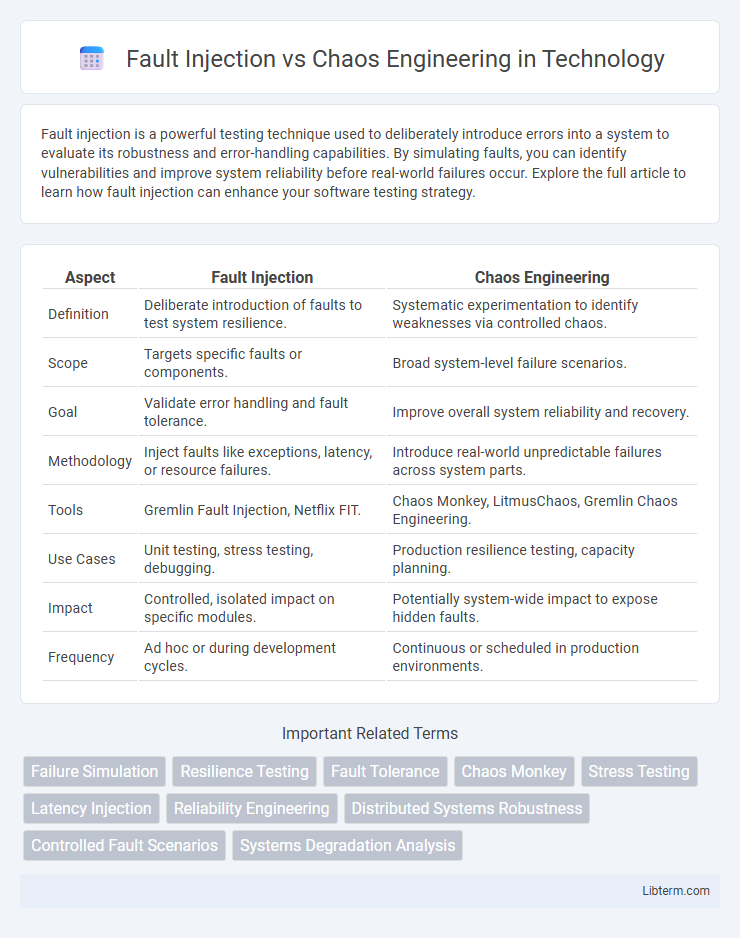Fault injection is a powerful testing technique used to deliberately introduce errors into a system to evaluate its robustness and error-handling capabilities. By simulating faults, you can identify vulnerabilities and improve system reliability before real-world failures occur. Explore the full article to learn how fault injection can enhance your software testing strategy.
Table of Comparison
| Aspect | Fault Injection | Chaos Engineering |
|---|---|---|
| Definition | Deliberate introduction of faults to test system resilience. | Systematic experimentation to identify weaknesses via controlled chaos. |
| Scope | Targets specific faults or components. | Broad system-level failure scenarios. |
| Goal | Validate error handling and fault tolerance. | Improve overall system reliability and recovery. |
| Methodology | Inject faults like exceptions, latency, or resource failures. | Introduce real-world unpredictable failures across system parts. |
| Tools | Gremlin Fault Injection, Netflix FIT. | Chaos Monkey, LitmusChaos, Gremlin Chaos Engineering. |
| Use Cases | Unit testing, stress testing, debugging. | Production resilience testing, capacity planning. |
| Impact | Controlled, isolated impact on specific modules. | Potentially system-wide impact to expose hidden faults. |
| Frequency | Ad hoc or during development cycles. | Continuous or scheduled in production environments. |
Introduction to Fault Injection and Chaos Engineering
Fault Injection involves deliberately introducing errors or faults into a system to test its resilience and identify vulnerabilities by simulating real-world failures. Chaos Engineering extends fault injection by systematically experimenting on distributed systems to ensure their robustness under unpredictable conditions through controlled, randomized disruptions. Both methodologies aim to improve system reliability but differ in scope, with Chaos Engineering focusing on holistic, large-scale environments.
Defining Fault Injection
Fault injection involves deliberately introducing errors or faults into a system to test its robustness and fault tolerance, targeting specific components to observe failure behavior. This technique helps identify vulnerabilities by simulating conditions such as hardware failures, software bugs, or network disruptions in a controlled environment. Fault injection differs from chaos engineering by focusing on predefined faults rather than unpredictable, large-scale system disruptions.
What is Chaos Engineering?
Chaos Engineering is a systematic approach to identify system vulnerabilities by intentionally injecting controlled faults and disruptions into distributed systems, enabling teams to observe real-time responses and improve resilience. Unlike traditional fault injection that targets specific components, Chaos Engineering tests the overall system behavior under unpredictable conditions to uncover hidden weaknesses. It leverages experiments such as server shutdowns, network latency, and resource exhaustion to validate failure recovery mechanisms and enhance reliability.
Key Differences Between Fault Injection and Chaos Engineering
Fault Injection targets specific, controlled faults to test system resilience, often isolating a single component or error scenario, whereas Chaos Engineering involves introducing unpredictable, random failures to observe overall system behavior under stress. Fault Injection typically focuses on detailed error types and precise fault simulation, while Chaos Engineering emphasizes systemic robustness by testing complex interactions across distributed systems. The scope of Fault Injection is narrower and more granular, contrasted with Chaos Engineering's broader, holistic approach to validating system stability.
Objectives of Fault Injection vs Chaos Engineering
Fault Injection aims to identify system vulnerabilities by deliberately introducing specific faults to test error-handling capabilities and resilience under controlled conditions. Chaos Engineering focuses on proactively verifying system robustness and reliability by simulating unpredictable and complex real-world failures to improve overall system stability. Both methodologies prioritize uncovering weaknesses, but Fault Injection targets precise fault scenarios, while Chaos Engineering emphasizes holistic system behavior under random disruptions.
Use Cases for Fault Injection
Fault injection is primarily used for testing specific failure conditions in controlled environments, enabling developers to validate error handling, improve system resilience, and identify vulnerabilities early in the development cycle. It is highly effective in scenarios such as simulating hardware faults, network outages, or API failures within microservices to observe system response and recovery mechanisms. This targeted approach contrasts with chaos engineering's broader, randomized testing of production systems to ensure overall system robustness under unpredictable real-world conditions.
Use Cases for Chaos Engineering
Chaos engineering is primarily used to improve system resilience by proactively identifying vulnerabilities in distributed systems through controlled experiments that simulate real-world failures such as server crashes, network latency, or database outages. Its use cases include validating failover mechanisms, testing auto-scaling policies, and ensuring consistent performance under unpredictable conditions. Organizations leverage chaos engineering to minimize downtime and enhance incident response by continuously exposing hidden weaknesses before they impact production.
Tools and Techniques in Fault Injection
Fault injection tools such as Chaos Monkey, Gremlin, and Pumba simulate failures by deliberately introducing errors like CPU spikes, network latency, or random process terminations to test system resilience. Techniques in fault injection involve hardware fault simulation, software fault injection, and network fault simulation to identify vulnerabilities under controlled failure scenarios. These tools provide granular control and repeatability, enabling targeted failure analysis within microservices, cloud infrastructure, and distributed systems.
Tools and Techniques in Chaos Engineering
Chaos Engineering employs sophisticated tools like Gremlin, Chaos Monkey, and LitmusChaos to systematically introduce faults, enabling precise control and automated experiment execution. Techniques include randomized failure injections, latency inductions, and resource starvation to observe system resilience under stress. These methods contrast with traditional fault injection by emphasizing proactive, incremental testing in production-like environments to uncover hidden vulnerabilities.
Choosing the Right Approach for System Resilience
Fault injection targets specific components by deliberately introducing errors to test system robustness, enabling precise identification of vulnerabilities. Chaos engineering emphasizes broader system behavior under unpredictable conditions, promoting resilience through continuous, real-world scenario experimentation. Selecting the right approach depends on the desired granularity of testing and the complexity of the system's architecture.
Fault Injection Infographic

 libterm.com
libterm.com